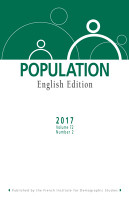
Population 2017, n°2
2017
Selective Adult Migration and Urban-Rural Mortality Differentials in Burkina Faso
Bruno Lankoande et Ali Sié, Winners of the 2017 Young Author Prize
Mortality Inequalities and Trends in Low- and Middle-Income Countries, 1990-2015
Dominique Tabutin and Bruno Masquelier
Changes in Family Size over the Generations in France (1850-1966)
Sandra Brée
A Survey of Adolescents Born with HIV : The TEEWA project in Thailand
Sophie Le Coeur, Éva Lelièvre, Cheeraya Kanabkaew, Wasna Sirirungsi
Selective Adult Migration and Urban-Rural Mortality Differentials in Burkina Faso
Bruno Lankoande, Ali Sié
Taking the example of Burkina Faso, where massive rural exodus continues to drive the urbanization process, this study tests the net effects of migration on urban-rural mortality differentials among adults aged 15-74. It is based on information collected at two demographic surveillance sites, one in a rural area (Nouna) and one in the city (Ouagadougou). The longitudinal data cover a recent period (2009-2013) and are analysed using a semi-parametric Cox model. In a rural environment with poor health conditions, it is the healthy individuals who migrate to the city, thereby strengthening the urban health advantage over the short term. While rural-urban
migrants are positively selected in terms of health, they tend to lose their advantage over time as they adapt to life in the city. This deterioration after several years of urban residence is probably holding back the mortality transition at national level, given that these migrants were in better health in their environment of origin. For return migrants (rural-urban-rural), the absence of a negative selection effect in Burkina Faso again reflects the complex interplay between migration and health. Beyond compositional and contextual effects, the positive selection of rural-urban migrants is accentuating the health disadvantage of rural areas.
Mortality Inequalities and Trends in Low- and Middle-Income Countries, 1990-2015
Dominique Tabutin and Bruno Masquelier
Between 1990 and 2015, life expectancy increased substantially in most low- and middle-income countries, although progress was very uneven. This article provides an overview of trends in early childhood mortality (0-5 years) and adult mortality (15-60 years) in the 109 low- and middle-income countries with populations of more than one million. It analyses trends in geographical and gender disparities across countries, and patternsof within-country inequalities (education, living standards, place of residence) in ten countries with very
different socioeconomic, political and demographic characteristics (Afghanistan, Bolivia, Brazil, Burkina Faso, China, Egypt, India, Indonesia, Nigeria, South Africa). It takes a new look at the epidemiological transition and makes a detailed analysis of AIDS mortality and maternal deaths. Progress has benefited children especially, and often (though not always) women and the most disadvantaged countries or social groups. It would be premature to speak of mortality convergence, however, since despite the progress made, inequalities between and within countries remain large and deserve particular attention from public health policy makers and
scientists.
Changes in Family Size over the Generations in France (1850-1966)
Sandra Brée
Through a longitudinal analysis of parities and parity progression ratios, this article charts the fertility of the cohorts of women born in France between 1850 and 1966. After reviewing the available sources and data (population censuses and family surveys), and the methods used for retrospective cohort analysis of fertility, the author proposes estimates of changing family sizes over more than a century. The simultaneous study of trends in family size and completed fertility enhances our understanding of fertility trends, and more specifically the impact of changes in each family size on overall fertility patterns. This refines the conclusions that can be
drawn from an interpretation of averages (completed fertility) by showing that, for the same completed fertility, the parity distribution can be highly variable, and demonstrates that family size should always be taken into account when analysing fertility. This research also highlights the value of differentiating between the fertility of all women, of ever-married women and of never-married women, particularly when analysing childlessness and low fertility (one child).
A Survey of Adolescents Born with HIV : The TEEWA project in Thailand
Sophie Le Coeur, Éva Lelièvre, Cheeraya Kanabkaew, Wasna Sirirungsi
Thailand is one of the Asian countries hardest hit by the HIV/AIDS epidemic. Before the widespread implementation, beginning in 1999, of programmes to prevent mother-to-child HIV transmission, many children were born with HIV in Thailand. They now reach adolescence thanks to antiretroviral treatments. While some qualitative studies have documented the family situation and the living conditions of these adolescents, the TEEWA (Teens Living With ARV) project has, for the first time, conducted a national quantitative survey among 10% of adolescents aged 12-19 infected with HIV at birth, under antiretroviral treatment, in order to assess their situation and compare it with that of adolescents in the general population. This article presents an original survey approach that takes into account the methodological and ethical issues specific to the situation of a population rendered doubly vulnerable by age and HIV status.
Prix TTC : 20,00 €

